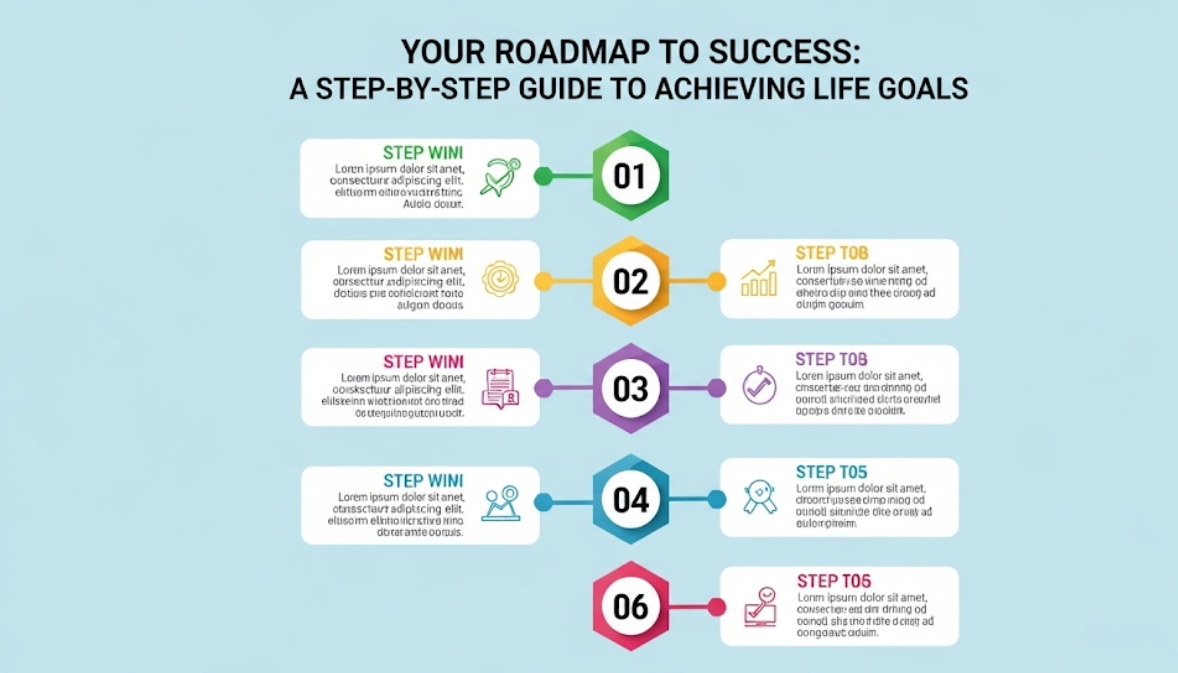Meta Description :
Transform your dreams into reality with this comprehensive guide to goal setting and achievement. Learn the proven SMART-ER method, 8-step blueprint, and advanced strategies successful people use. Includes real success stories, common mistakes to avoid, and tools to create your personal goal achievement system. Start designing your dream life today.
A Step-by-Step Guide to Setting and Achieving Life Goals
Having no clear goals is like going on a road trip without a GPS — you are setting yourself up to end in places you never expected yourself to be. Whether you are 15 or 50, having a plan for the future determines the difference between just flowing through life and actually designing your dream life.
So here is a comprehensive guide to provide all the information you need to gain deep knowledge about how to set goals and achieve them. In this guide, you will find strategies, tools and action steps for how successful people actually make their dreams a reality.
Why Goal Setting Really Matters
Goals are not simply something you aim for, but what gives your life direction and meaning. One way to make a plan is to set some target of what you want because when you have a clear goal, your brain will automatically seek the opportunities to reach there. It’s like programming your internal GPS so the fastest road to where you want to go is reached with utmost ease.
Why It Works: Research has shown that people who write down their goals are 42% more likely to actually achieve them. This isn’t just luck, but the power of having a good, clear plan and proper priorities.
The Power of the Mind in Goal Achievement
The reality is your brain wants you to succeed, but only if you are specific about what you want. When you set a clear goal in your mind, something amazing happens: Your brain starts working on what scientists call the Reticular Activating System (or RAS for short). This system will allow you to see options, resources and solutions that were always there but out of sight.
The SMART-ER Method: Your Goal Setting Framework
Take everything you know about SMART goals and crank it up a notch with the SMART-ER method. This improved framework will ensure that you take the right approach to accomplishing what you set out to do.
S – Specific and Detailed
Unclear goals lead to unclear results. For example: not “I want to get in shape” but rather:
Example: “I will exercise 4 times per week and eat 5 servings of vegetables per day to lose 15 pounds.”
Example: “I am going to save $5,000 for a vacation by saving $200 every month.”
M – Measurable Progress Tracking
As the old saying goes, you can’t manage what you don’t measure. All goals must have numbers or definite objectives:
- Physical: pounds lost, health improved, sleep increased
- Financial: money saved, debt reduced, income increased
- Career: skills learned, projects completed, promotions earned
A – Achievable Yet Challenging
You should set your goals to stretch you — not break you! Be about 70% certain that you can accomplish your goal: hard enough to push yourself, but reasonable enough to keep going.
R – Relevant to Your Values
Your goals need to matter. They need to be meaningful to you. Ask yourself:
- Is this goal in line with who I aspire to be as a person?
- How will accomplishing this make life more enjoyable for me?
- Am I setting this goal for myself or someone else?
T – Time-Bound with Deadlines
Every goal needs a finish line. Without deadlines, goals become wishes. Create final deadlines as well as intermediate checkpoints.
E – Exciting and Inspiring
Your goals should excite you, not exhaust you. If thinking about your goal does not make you excited, there is a good chance you need to change it or find a better “why” behind it.
R – Reviewed and Revised Regularly
Goals aren’t set in stone. Life changes, priorities shift and new opportunities appear. Conduct monthly reviews to track progress across all goals and tweak variables as required.
The 8-Step Goal Achievement Blueprint
This comprehensive process is how to take any goal from idea to reality:
Step 1: Conduct a Life Audit
Before selecting your new goals, take an honest (and compassionate) look at where you are now:
Career Assessment:
- Where do you derive your energy from at work?
- What skills would you like to develop?
- Where do you see yourself in 5 years?
Personal Relationships:
- Which relationships enrich your life?
- What kind of person do you want to be?
- What impact do you want to make in the world?
Health and Wellness:
- What does your optimal health look like?
- Which habits support your well-being?
- What physical activities do you avoid doing?
Financial Situation:
- Where do you stand in terms of assets and liabilities?
- What does financial security mean to you?
- How do you want to live your life financially?
Step 2: Choose Your Focus Areas
Stop trying to transform everything at once. Choose 2-3 key areas where you want to see significant progress over the next year. Common focus areas include:
- Career and Professional Growth
- Health and Fitness
- Relationships and Social Life
- Financial Security and Wealth Building
- Personal Development and Learning
- Adventure and Experiences
Step 3: Set Your Core Goals
Write down one specific and major goal for each area of focus, following the SMART-ER method. Write each goal as a sentence using “I will…”
Example Goal Statements:
- “I will get my project management certification by December 31st through studying for an hour every day and taking practice exams once a week.”
- “I will run a half-marathon in under 2 hours by October 15th using a 16-week training plan.”
- “I will build a $10,000 emergency savings account by December 31st through automatically transferring $850 each month to a high-yield savings account.”
Step 4: Break Goals into Action Steps
Large goals can feel overwhelming. Divide every major goal into smaller, actionable steps.
Examples:
- Goal: Lose 25 pounds → Action steps: meal prep on Sundays, walk 10,000 steps daily, track calories using an app
- Goal: Learn Spanish fluently → Action steps: use language learning app for 30 minutes daily, watch Spanish movies weekly, find a conversation partner
- Goal: Save $10,000 → Action steps: track all expenses, review budget weekly, set up automatic transfers
Step 5: Identify Resources and Support
Success rarely happens in isolation. Identify what you need to reach your destination:
Resources Needed:
- Books, courses, or training materials
- Equipment or tools
- Financial investment
- Time allocation
Support System:
- Mentors or coaches
- Accountability partners
- Family and friend support
- Online communities or groups
Step 6: Anticipate Obstacles and Plan Solutions
Every goal journey includes challenges. Plan your strategies to tackle the most common obstacles:
Common Obstacles and Solutions:
Lack of Time:
- Solution: Time audit and priority reset
- Backup: Wake up 30 minutes earlier, or use lunch breaks
Motivation Dips:
- Solution: Visual reminders and reward system
- Backup: Get an accountability partner
Unexpected Expenses:
- Solution: Financial goals need buffer room
- Backup: Identify ways to increase income
Skill Gaps:
- Solution: Invest in learning and development early
- Backup: Find mentors or take online courses
Step 7: Set Up Your Tracking System
What gets measured gets managed. Choose tracking methods that fit your lifestyle:
Digital Options:
- Goal-tracking apps like Habitica, Strides, or Way of Life
- Spreadsheets with progress charts
- Phone reminders and calendar blocks
Physical Options:
- Goal journal or planner
- Wall calendar with milestones
- Progress charts and visual displays
Hybrid Approach:
- Weekly digital check-ins
- Monthly physical review sessions
- Quarterly goal meetings with yourself
Step 8: Create Your Review System
Regular reviews keep you on track and help you adapt when needed:
Daily Check-ins (5 minutes):
- Review today’s priority actions
- Plan tomorrow’s goal-related tasks
- Note any obstacles or wins
Weekly Reviews (30 minutes):
- Assess progress toward weekly targets
- Plan goal-related activities for the new week
- Adjust tactics if needed
Monthly Evaluations (1 hour):
- Measure progress against monthly milestones
- Celebrate successes and learn from setbacks
- Tweak action plans based on what’s working
Quarterly Assessments (2-3 hours):
- Review overall goal progress
- Modify any significant goals or timelines
- Set new quarterly milestones
Common Goal-Setting Mistakes to Avoid
Learning from others’ mistakes can save time and frustration:
Mistake #1: Setting Too Many Goals
The Problem: Splitting your focus among 10 different goals means minimal progress on any one of them.
The Solution: Master 2-3 main goals per year before adding more.
Mistake #2: Making Goals Too Vague
The Problem: “Get healthy” and “make more money” are vague directions.
The Solution: Clearly define what success looks like and how you’ll measure it.
Mistake #3: Not Understanding Your Why
The Problem: Goals without personal motivation are weak.
The Solution: Connect every goal to your deeper values and life vision.
Mistake #4: Perfectionism Paralysis
The Problem: Waiting for the perfect plan or the right moment means never starting.
The Solution: Begin with an imperfect plan and refine as you go.
Mistake #5: Not Planning for Setbacks
The Problem: One bad day derails the entire goal.
The Solution: Expect challenges and prepare comeback strategies.

Advanced Goal Achievement Strategies
Now that you have the fundamentals, here are advanced techniques to accelerate your success:
The 1% Better Principle
Small, consistent improvements compound over time. Instead of trying to change everything overnight, focus on getting just 1% better every day. This approach is less overwhelming and more sustainable.
Examples:
- Read 2 pages daily instead of aiming for 1 book per week
- Add 5 minutes to your walk rather than jumping to hour-long workouts
- Save $5 more each day instead of trying to cut expenses by $150 immediately
Environment Design
Your environment is stronger than your willpower. Design your surroundings to make good habits easier:
- Lay out workout clothes the night before
- Keep healthy snacks visible and junk food hidden
- Create a dedicated workspace with all materials ready
Implementation Intentions
Rather than just deciding what to do, also decide when and where you’ll do it. Research shows that creating “if-then” plans doubles your chances of following through.
Examples:
- “At 6 AM on weekdays, I will take a 20-minute walk”
- “On Sundays at 2 PM, I will meal prep for the entire week”
Social Accountability
Share your goals with others and ask for support. Public commitment creates positive pressure to take action:
- Join or create a goal group
- Share progress updates on social media
- Partner with someone who has complementary goals
Real Goal Achievement Success Stories
Example 1: Career Transition Goal
Background: Sarah, 28, stuck in a job she hated with no clear direction
Goal: “I will transition into UX design and land my first job within 18 months”
Action Plan:
- Complete online UX design certification (Months 1-6)
- Build 3 portfolio case studies (Months 4-9)
- Network with UX professionals (ongoing)
- Apply to jobs (Months 12-18)
Results: Sarah landed her first UX job in month 16 with a 35% salary increase.
Example 2: Health and Fitness Goal
Background: Mike, 35, 40 pounds overweight, never exercised regularly
Goal: “I will lose 40 pounds and run a 5K in under 30 minutes within one year”
Action Plan:
- Start with 20-minute walks 3x per week (Month 1)
- Begin Couch to 5K running program (Month 2)
- Track calories and maintain 500-calorie daily deficit
- Meal prep healthy lunches weekly
Results: Mike lost 42 pounds in 11 months and completed his first 5K in 28 minutes.
Maintaining Momentum When Progress Stalls
Every goal journey includes plateaus. Here’s how to push through:
The Plateau Strategy
When progress stalls:
- Assess the basics: Are you still doing the fundamental actions?
- Increase intensity: Add 5-10% more effort to your current actions
- Try a different approach: If one method isn’t working, test alternatives
- Focus on process: Celebrate consistent effort, even when results seem slow
The Comeback Plan
When you fall off track:
- Restart immediately: Don’t wait for Monday – begin now
- Scale down: If you were exercising 1 hour daily, restart with 20 minutes
- Identify the cause: Address root problems, not just symptoms
- Adjust your plan: Goals sometimes need tweaking based on new circumstances
Creating Your Personal Goal Achievement System
Now it’s time to put everything together into your customized system:
Your Goal Dashboard
Create a one-page summary containing:
- Your top 2-3 goals for the year
- Key milestones and deadlines
- Daily and weekly action items
- Progress tracking methods
- Support system contacts
Your Review Schedule
Create recurring calendar appointments for:
- Daily goal check-ins (5 minutes)
- Weekly progress reviews (30 minutes)
- Monthly goal assessments (1 hour)
- Quarterly strategy sessions (2-3 hours)
Your Success Metrics
Define specifically how you’ll measure progress:
- Leading indicators: Actions you control
- Lagging indicators: Results you want
- Milestone celebrations: Planned in advance
The Goal Achievement Mindset
Successful goal achievement isn’t just about having the right system – it’s also about developing the right mindset:
Growth vs. Fixed Mindset
Fixed Mindset: Believes intelligence, talents and abilities are static traits; sees failure as proof you can’t do something
Growth Mindset: Views challenges as learning opportunities, not dead ends
Action Step: When facing difficulties, ask “How can I improve this?” rather than “Why can’t I do this?”
Process vs. Outcome Focus
Outcome Focus: Only celebrates end results
Process Focus: Finds satisfaction in consistent effort and small improvements
Balance: Set outcome goals (lose 20 pounds) alongside process goals (exercise 4x per week)
Long-term vs. Short-term Thinking
Short-term: Seeks immediate results and quick fixes
Long-term: Understands that lasting change takes time and patience
Action Step: When motivation dips, reconnect with your long-term vision and remember why you started
From Dreamer to Achiever: Your Next Steps
The only thing that separates dreamers from achievers is an actionable plan. With these tools, strategies, and insights, you now have everything you need to set and achieve any goal you desire.
Remember that goal achievement is a skill that improves with practice. Your first goals might take longer as you figure out what works for you. That’s completely normal and part of the learning process.
Start today, even if it’s just writing down one goal and taking one small step toward it. A journey of a thousand miles begins with a single step, and your future self will thank you for taking that step now.
The goals you set and achieve over the coming months won’t just change your results – they’ll change who you become. So set them, commit to them, and trust the process. Your dreams are waiting to become plans, and your plans are waiting for action.
Success isn’t about being perfect – it’s simply about persisting longer than most people do. Start where you are, use what you have, do what you can. Your goal achievement journey begins now.




